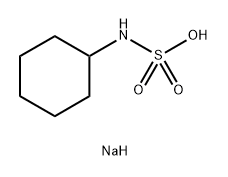
Natriumcyclamat
Bezeichnung:Natriumcyclamat
CAS-Nr139-05-9
Englisch Name:Sodium N-cyclohexylsulfamate
CBNumberCB8713674
SummenformelC6H14NNaO3S
Molgewicht203.23
MOL-Datei139-05-9.mol
Synonyma
Natriumcyclamat
Natriumcyclamat physikalisch-chemischer Eigenschaften
| Schmelzpunkt | >300 °C (lit.) |
| Dichte | 1.58[at 20℃] |
| Dampfdruck | 0.002Pa at 150℃ |
| storage temp. | room temp |
| Löslichkeit | 200g/l |
| Aggregatzustand | Powder |
| Farbe | White |
| PH | 5.5-7.5 (100g/l, H2O, 20℃) |
| Geruch (Odor) | Odorless. Sweet taste, perceptible at concentrations higher than 100 ppm in water. |
| Wasserlöslichkeit | >=10 g/100 mL at 20 ºC |
| Merck | 14,2703 |
| BRN | 4166868 |
| Stabilität | Hygroscopic |
| InChIKey | UDIPTWFVPPPURJ-UHFFFAOYSA-M |
| LogP | -2.63 at 20℃ |
| CAS Datenbank | 139-05-9(CAS DataBase Reference) |
| IARC | 3 (Vol. Sup 7, 73) 1999 |
| EPA chemische Informationen | Sodium cyclamate (139-05-9) |
| Kennzeichnung gefährlicher | Xn |
| R-Sätze: | 22 |
| S-Sätze: | 36/37-24/25 |
| WGK Germany | 3 |
| RTECS-Nr. | GV7350000 |
| TSCA | Yes |
| HS Code | 29299000 |
| Toxizität | Sodium cyclamate is a non-nutritive sweetener that is about 30 times sweeter than cane sugar. The oral LD50s in rats and mice are 15.25 and 17.0 g/kg, respectively. It was banned as a food additive because of findings that it caused bladder cancer in rodents. It appears to act as a promoter. There is also evidence that it causes toxicity in the male reproductive system. |

